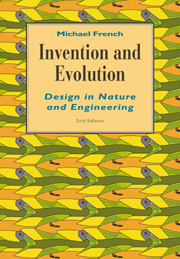Book contents
- Frontmatter
- Contents
- Preface to the second edition
- Preface to the first edition
- Acknowledgements
- 1 The designed world
- 2 Energy
- 3 Materials
- 4 Mechanism
- 5 Structures
- 6 Systems
- 7 The practice, principles and philosophy of design
- 8 Economy, form and beauty
- 9 Production, reproduction, evolution and design
- 10 Designing and inventing
- 11 Some case studies
- Questions
- Answers
- Suggestions for further reading
- Index
1 - The designed world
Published online by Cambridge University Press: 06 January 2010
- Frontmatter
- Contents
- Preface to the second edition
- Preface to the first edition
- Acknowledgements
- 1 The designed world
- 2 Energy
- 3 Materials
- 4 Mechanism
- 5 Structures
- 6 Systems
- 7 The practice, principles and philosophy of design
- 8 Economy, form and beauty
- 9 Production, reproduction, evolution and design
- 10 Designing and inventing
- 11 Some case studies
- Questions
- Answers
- Suggestions for further reading
- Index
Summary
Design
Suppose we are asked which of these three is the odd one out, a waterfall, a buttercup and a steam locomotive. One answer would be, the locomotive, because it alone is man-made, another would be, the buttercup, because it alone is alive. But the third possible answer would also be justifiable: the buttercup and the locomotive show evidence of design, but the waterfall does not – its shape simply happens, it has no symmetry, it is not contrived to have any function or to serve any end. The locomotive and the buttercup show symmetry and regularity – several wheels or petals all the same shape, a long regular frame with wheels attached below in pairs, or a long regular stem with leaves arising from it. All the parts of both are adapted to particular purposes, purposes which serve greater ends – in the buttercup, to survive, to grow and propagate its kind, in the locomotive, to haul goods and passengers.
It is easy to recognise that the locomotive is a work of knowledge and cunning and that the relations of its many parts are subtle and exact. It is clear, too, that it is simplicity itself compared with the intricacies of the buttercup. Nevertheless, these two designs, so different in appearance and nature, are informed by the same principles, subject to the same practical necessities and demonstrate similar answers to similar problems.
- Type
- Chapter
- Information
- Invention and EvolutionDesign in Nature and Engineering, pp. 1 - 22Publisher: Cambridge University PressPrint publication year: 1994



